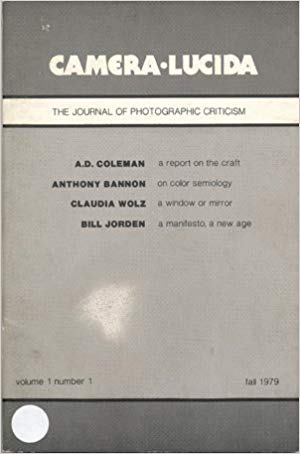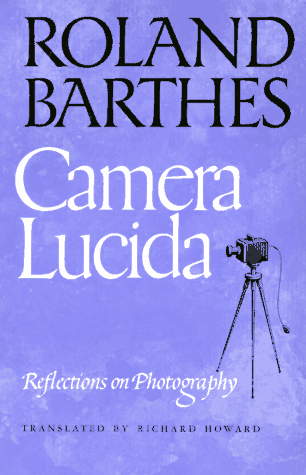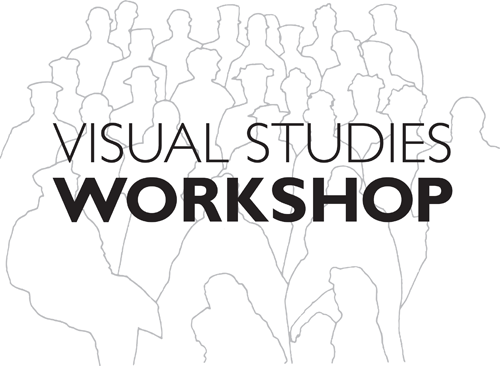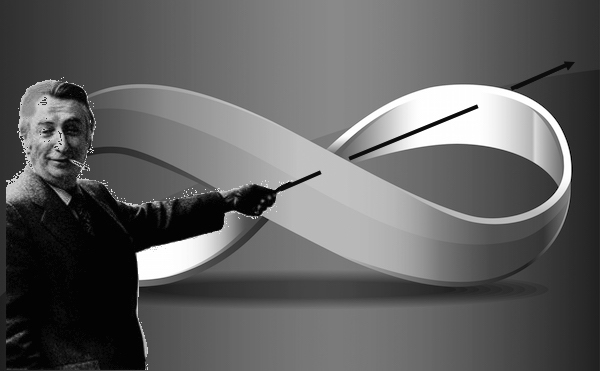 [Just over 40 years ago, on May 18, 1979, I presented this paper at the Photographers Forum Symposium “Contemporary Trends in Photographic Criticism,” held at the New School for Social Research, New York. (As you can see from the event’s title, the misuse of the adjectival form of “photography” as a modifier had already spread beyond the confines of photo education.)
[Just over 40 years ago, on May 18, 1979, I presented this paper at the Photographers Forum Symposium “Contemporary Trends in Photographic Criticism,” held at the New School for Social Research, New York. (As you can see from the event’s title, the misuse of the adjectival form of “photography” as a modifier had already spread beyond the confines of photo education.)
The Photographers Forum was a short-lived attempt to revive the ethos of the Photo League, masterminded by such unregenerate old Stalinists as photographers Lou Stettner and Walter Rosenblum. They had as their clear purpose the haranguing of photographers who strayed from the path of traditional documentary, such as Duane Michals and Ralph Gibson, whom they invited to such events in order to confront and attack them for their lack of commitment to “scientific socialism” and failure to address the lives of the working class.
I decided to use the occasion as an opportunity to deliver another installment of what became a long series of periodic assessments of the condition of photo criticism, both in my own locale and elsewhere (to the extent that I was able to learn of that). It pains me to say that nothing really changed for the better over the following four decades; to the contrary, they managed to get even worse, as summarized in my November 2011 follow-up, “Dinosaur Bones: The End (and Ends) of Photo Criticism.”
At this remove I have only the haziest recollection of the event, but I do recall getting chastised for paying way too much critical attention to work the symposium organizers considered politically incorrect, and not nearly enough to work that manifested the appropriate degree of ideological rectitude (for which read: theirs, and that of their acolytes). This despite the fact that, even by 1979, I had addressed far more documentary work, past and present, than any critic preceding me, as well as any of my generation. How sharper than a serpent’s tooth …
![]() The unnamed critic to whom I refer as the author of risibly archaic party-line commentary on Robert Frank’s photograph “Sagamore Cafeteria” was in fact the selfsame Lou Stettner, who at the time wrote a column – as did I – for the magazine Camera 35 (his under the rubric “Speaking Out,” where the line I quote appeared), and who, with Rosenblum, moderated this symposium. Stettner’s online biography at his estate’s website notes that, among other accomplishments, “In 1975, he was awarded First Prize at the Pravda World Contest for Photography and spent six weeks photographing the Soviet Union.”
The unnamed critic to whom I refer as the author of risibly archaic party-line commentary on Robert Frank’s photograph “Sagamore Cafeteria” was in fact the selfsame Lou Stettner, who at the time wrote a column – as did I – for the magazine Camera 35 (his under the rubric “Speaking Out,” where the line I quote appeared), and who, with Rosenblum, moderated this symposium. Stettner’s online biography at his estate’s website notes that, among other accomplishments, “In 1975, he was awarded First Prize at the Pravda World Contest for Photography and spent six weeks photographing the Soviet Union.”
The text of this talk was originally published in Camera Lucida: The Journal of Photographic Criticism, Vol. 1, no. 1, Fall 1979. Subsequently it appeared in my 1996 collection of essays, Tarnished Silver: After the Photo Boom. – A.D.C.]
•
Photography Criticism:
A State-of-the-Craft Report
Shortly before his recent death, art critic Thomas Hess called for “twenty years of cold, boring formalist criticism of photography, beginning with this question: If the lens is round, and the image is square, what happens in the corners?” Unfortunately, Hess did not live long enough to answer his own burning query, though I’m sure that somewhere out there some eager beaver is plotting it all out with charts and graphs.
 From an almost diametrically opposite standpoint, another critic recently gave us this reading of Robert Frank’s photograph “Sagamore Cafeteria,” which shows a group of smiling female office workers: “The picture reveals the quiet optimism, the self-confidence of working people (which I believe stems from their intuitive belief that they will eventually triumph as a class).”
From an almost diametrically opposite standpoint, another critic recently gave us this reading of Robert Frank’s photograph “Sagamore Cafeteria,” which shows a group of smiling female office workers: “The picture reveals the quiet optimism, the self-confidence of working people (which I believe stems from their intuitive belief that they will eventually triumph as a class).”
To envision these two gentleman together in a room, each attempting to persuade the other of the overriding importance of his own stance, is to conjure up a futile, eternal, hellish wrangling worthy of Jean-Paul Sartre himself.
•
Back in 1974, I described the state of photography criticism as “pre-critical mass.” I felt, at that time, that the crucial problems in the field of photo criticism included the minuscule number of practitioners of the craft and the lack of sufficient forums and outlets for critical writing on photography.
This no longer holds true. The ranks of photography critics have swelled considerably in the interim. And although regrettably few major newspapers and magazines have opened their pages to photography criticism, the number of smaller, more specialized publications has grown rapidly. They are hungry for intelligent writing, and there are enough of them that anyone entering the critical arena in a committed way is not likely to go unpublished – though he or she is likely to go unpaid.

Camera Lucida, Vol. 1, no. 1, 1979 (cover)
So I’d revise my estimate at this point. The stage of critical mass has been reached. Yet I am not convinced that we have come any closer to achieving the goal that purportedly underlies all this activity: the creation of a meaningful critical dialogue in photography. By this I mean neither the unilateral pronunciamentos of camp followers nor the internecine warfare within one or another critical mode, but rather a wide-open, ongoing, interconnected discussion of current issues and contemporary work, a discussion in which all members of the critical circuit – critics, image-makers, and audience – are all actively engaged.
This strikes me as the obvious next stage in the development of photography criticism. Yet it seems to me that photography criticism at present is – or is felt to be by its practitioners – caught between the Scylla of academic writing addressed to an elite and the Charybdis of a more practical, colloquial stance intended to engage a wider audience.
One could give these tendencies other names – theoretical instead of academic, applied in place of practical – but the principles and issues would remain the same. On the one hand, there are factors such as the increasing interconnection between photography and other media, the dramatic and continuing expansion of the cumulative body of imagery subsumed under the rubric of “photography history,” and the current burst of infrastructural inquiry on the part of photographers and other image-makers involved with the medium. All these seem to direct the practitioner of that ancillary form known as criticism toward a formalist, hermeneutic frame of reference aimed at those most single-mindedly engrossed with the photographic image: scholars, historians, photographers, artists, and other critics.

Roland Barthes, “Camera Lucida” (1981), cover.
On the other hand, the small size of the current audience for photography – small in relation to the volume of imagery now being generated, and small in contrast to what appears to be the potential size of that audience – makes it painfully clear that the medium is reaching neither the maximum nor the optimum number of people. The critic-as-aesthete can disregard this situation and disclaim responsibility for it; the critic-as-intermediary cannot.
This may seem to be much too mundane an issue to broach. But the longer I remain in the field of photography criticism, the clearer it becomes that one central question is, “To whom is my/your/our work addressed?”
Based on what I’ve been reading (and where I’ve been reading it) over the past several years, I’m of the opinion that we’re tending more and more to talk to ourselves. Rather than working to build and educate an ever-growing audience for the medium, our writing in aggregate seems directed principally to those who don’t really need it: the existing cadre of the visually sophisticated.
This signals something askew in our priorities. The medium at present is undergoing not only a period of tremendous, energizing redefinition from within, but also a time of concentrated attention from without. It is a juncture that contains the potential for rapid expansion of the engaged audience for photography.
The purpose of such expansion would not be critics’ self-aggrandizement, but the broadening of the medium’s base of knowledgeable support. Such growth will be necessary for the medium’s continued health. Indeed, the development of such an increasingly alert audience is presumably one of the primary reasons why photographers – and critics – put their work out in the public eye in the first place.
 So it seems somewhat ironic to me that with more photographic imagery than ever before being published, exhibited, and collected, and with an audience more primed for the medium than any we’ve had for a long time, I’m finding proportionately less to read about this ferment and the specific works contributing to it in publications directed at that audience – less than we had even five or six years ago.
So it seems somewhat ironic to me that with more photographic imagery than ever before being published, exhibited, and collected, and with an audience more primed for the medium than any we’ve had for a long time, I’m finding proportionately less to read about this ferment and the specific works contributing to it in publications directed at that audience – less than we had even five or six years ago.
I’m not speaking here of the specialized publications – the large-circulation camera magazines (the quality and volume of whose critical coverage has increased significantly in recent years), the art-critical journals finally paying some heed to photography, or the “little magazines” of the medium, whose number has continued to rise. I’m speaking of general-interest newspapers and magazines.
New York being our own locale, let me use it as an example. Six years ago there might have been an average of 100-150 significant photography books published each year. Roughly one-third of those would receive some critical attention – and thus some exposure to readers – in the Village Voice and/or in one or another section of the New York Times. Today, with perhaps four times as many photo books coming out per annum, there are numerically fewer critical discussions of them in those periodicals.
![]() Similarly, while the number of galleries, museums, and other institutions exhibiting photographs has multiplied a hundredfold since the late 1960s, the number of exhibitions reviewed in the Voice and the Times has decreased steadily during this period. And it is only at the SoHo Weekly News and – to a much lesser extent – at the New Yorker that space for photography criticism can be said to have opened up in any of this city’s general-interest publications.
Similarly, while the number of galleries, museums, and other institutions exhibiting photographs has multiplied a hundredfold since the late 1960s, the number of exhibitions reviewed in the Voice and the Times has decreased steadily during this period. And it is only at the SoHo Weekly News and – to a much lesser extent – at the New Yorker that space for photography criticism can be said to have opened up in any of this city’s general-interest publications.
Surely the cause of this is not the lack of an interested readership. To some extent we can attribute it to benighted editors. And, without blameful intent, we might trace some of it to an understandable inclination on the part of those critics with access to such forums to write extended considerations of a few exhibits rather than capsule reviews of many.
Yet, whatever the cause, the fact remains that it’s a rare book or exhibit that will receive critical attention in more than one New York-based general-interest publication. And though a great deal of the current volume of photography criticism emanates from New York, I find it’s a rare critic of the medium who’s writing in a language designed to be accessible to such readers. Consequently, should the benighted editors I’ve just mentioned suddenly see the light, I for one would be hard-pressed to tell more than one or two of them where to look for substantial yet accessible writing.
 Without meaning to negate the potential usefulness of formalist criticism at one extreme and politically programmatic criticism at the other, I do want to suggest that with these as the dominant modes of critical discourse in photography we are more likely to alienate the public from the medium than to encourage that public to engage actively with either the criticism or – dare I even mention them? – the primary works themselves.
Without meaning to negate the potential usefulness of formalist criticism at one extreme and politically programmatic criticism at the other, I do want to suggest that with these as the dominant modes of critical discourse in photography we are more likely to alienate the public from the medium than to encourage that public to engage actively with either the criticism or – dare I even mention them? – the primary works themselves.
What we need, it seems to me, is a group of critics less interested in equating themselves with photographers or aligning themselves with curators, gallery owners, and other critics, and more actively committed to functioning as articulate intermediaries between the work of photographers and the largest potential audience for that work. Such positioning is another form of “knowing where to stand,” and is no less important in photography criticism than in photography.
•
Finally, a brief afterthought.
 In assessing the Second Conference on Photography Criticism, which took place at the Visual Studies Workshop in April of 1977, I suggested that we needed a greater willingness to be brutal on the part of photography critics. I wasn’t thinking of the brand of thuggee being practiced by at least one local critic, but rather of the general absence of clear, high, difficult-to-meet standards for work done in all the various modes of photography.
In assessing the Second Conference on Photography Criticism, which took place at the Visual Studies Workshop in April of 1977, I suggested that we needed a greater willingness to be brutal on the part of photography critics. I wasn’t thinking of the brand of thuggee being practiced by at least one local critic, but rather of the general absence of clear, high, difficult-to-meet standards for work done in all the various modes of photography.
As critics, I think we’ve come to accept a shockingly low level of research, fieldwork, articulacy, fore- and afterthought, and commitment from photographers. For example, we’re prone to consider any image of any urban situation as constituting a “social comment,” and any body of such images as a social critique. We tolerate photographers’ one- and two-week junkets into other cultures or subcultures, and the presentation of their uninformed snap judgments, as “in-depth studies.” An attention to one or another subject so fleeting that it would be considered scandalous in any other discipline is accepted without question in photography.

Roland Barthes with punctum and moebius strip. Photo-illustration by A. D. Coleman, 2016.
Perhaps photography critics tend to be generous in this regard in the hope that others will be equally generous to them in their pretensions. I think there may be value to psychoanalytic, structuralist, and political analysis of photographs specifically and photography in general. But we degrade not only our profession but its basic tool, the language, when we tolerate “Marxist” critiques from writers who do not appear to have read Kapital, psychoanalytic interpretations from people who’ve browsed through a bit of Jung and Freud, and semiological exegeses from those whose credentials consist of occasional epigrams from Barthes and Levi-Strauss.
(Everybody talkin’ semiotics ain’t a-doin’ it; indeed, I suspect that much of what’s passing for “structuralist” criticism in photography and the other media would be considered sophomoric at best by trained semioticians.)
So, in suggesting that we need more critical brutality, let me conclude by proposing that some of it be directed toward ourselves; like charity, brutality properly begins at home.
•
Special offer: If you want me to either continue pursuing a particular subject or give you a break and (for one post) write on a topic — my choice — other than the current main story, make a donation of $50 via the PayPal widget below, indicating your preference in a note accompanying your donation. I’ll credit you as that new post’s sponsor, and link to a website of your choosing.
 Include a note with your snail-mail address (or email it to me separately) and I’ll include three (3!) copies of The Silent Strength of Liu Xia, the catalog of the 2012-13 touring exhibition of photos by the dissident Chinese photographer, artist, and poet, who, after eight years of extralegal house arrest in Beijing, finally got released and expatriated to Germany in 2018. The only publication of her photographic work, it includes all 26 images in the exhibition, plus another 14 from the same series, along with essays by Guy Sorman, Andrew Nathan, and Cui Weiping, professor at the Beijing Film Academy. Keep one for yourself, share the others with friends.
Include a note with your snail-mail address (or email it to me separately) and I’ll include three (3!) copies of The Silent Strength of Liu Xia, the catalog of the 2012-13 touring exhibition of photos by the dissident Chinese photographer, artist, and poet, who, after eight years of extralegal house arrest in Beijing, finally got released and expatriated to Germany in 2018. The only publication of her photographic work, it includes all 26 images in the exhibition, plus another 14 from the same series, along with essays by Guy Sorman, Andrew Nathan, and Cui Weiping, professor at the Beijing Film Academy. Keep one for yourself, share the others with friends.





Re: “The Photographers Forum was a short-lived attempt to revive the ethos of the Photo League, masterminded by such unregenerate old Stalinists as photographers Lou Stettner and Walter Rosenblum.”
Have I seen that somewhere in the papers of Joe McCarthy? I admire The Photo League and what it did accomplish during a more liberal time.
I share your respect for the Photo League (1936-51). Its membership included people of all political tendencies, though probably few if any on the right found its atmostphere hospitable.
And I accept the fact that once upon a time — especially outside the USSR, where information about his criminal regime proved scanty at best — one could endorse “Uncle Joe” in relatively good conscience. Surely many Photo Leaguers did so, and I don’t necessarily consider that to their discredit.
However, by 1979 (the year of this symposium) doing so involved embracing the show trials, the Molotov–Ribbentrop Pact, the Katyn Forest massacre, the gulags, and a host of other horrors. Despite all that, Rosenblum and Stettner made no bones about their continued allegiance to Stalin and Stalinism. So I’m not leveling an accusation here, simply describing their political positions on the left-wing spectrum. Nothing McCarthyite about that.
What made their “struggle sessions” (as Maoism would name them) so retro and irrelevant is that accusations of various forms of “left deviationism” only matter to people who have committed themselves to the party and the party line. (For people who haven’t — like Michals, Gibson, and myself — the only logical response is “So what?”) And the accusers had no power to punish the errant, thus defining themselves as impotent in their self-assigned roles as enforcers of political correctness.
For a resonant, detailed account of a U.S “show trial” conducted by the CPUSA in its heyday, I highly recommend Richard Wright’s American Hunger, originally intended as the concluding section of his classic Black Boy but withheld from that book and later published separately.
I had my own personal experience of the show trial, in my case conducted against me by the late Allan Sekula at the conclusion of a seminar that was part of the NYU Tisch Photo Department’s summer photography program sometime in the mid-1980s. The transcript was withheld from publication at Sekula’s request. The most memorable moment came when Sekula complained, “I’m confessing more than you are!”